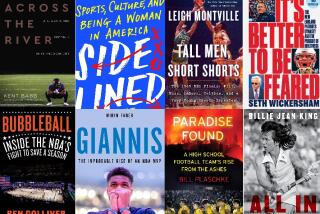Outdoor Magazines Take a Shot at Attracting New Readers
- Share via
Heightened competition in the outdoor sports arena is prompting publishers of competing magazines to rethink their strategies, particularly among magazines that traditionally have courted hunters and gun enthusiasts.
Guns & Ammo, for example, is sticking to its guns by redoubling its emphasis on entertaining, informing and educating sportsmen for whom rifles and handguns are as much a part of the sporting life as a long board is for a surfer. But the August issue of Sports Afield magazine lists the hippest towns for mountain biking and includes a feature story about hikers who mooch their daily necessities from passersby.
Publishers are scrutinizing editorial content because the number of traditional sportsmen has stalled--along with subscriptions for some major magazines, including Hearst Corp.’s Sports Afield and Field & Stream, owned by Times Mirror Corp., which also publishes the Los Angeles Times.
The number of hunting permits issued, for example, has fallen over the past decade, and suburban housing tracts continue to eat away at traditional hunting grounds. And, observers say, youthful consumers are more likely to pick up skateboards and mountain bikes than shotguns and rifles.
“A large number of people still participate in hunting and fishing, but participation is not growing, so some magazines are trying to find ways to position themselves in other types of outdoor adventures,” said Michael J. Wolf, who directs the media and entertainment business for New York-based consulting firm Booz Allen & Hamilton.
Both strategies--sticking to a well-defined niche and broadening a magazine’s appeal--include risks. Magazines that settle into too narrow a niche risk fading away as their subscribers age. Magazines that move too far afield from their traditional area of coverage risk alienating or confusing their subscribers.
And, as traditional outdoor magazines add articles about such topics as river paddling, they are bumping up against other competitors. Sports Afield, for example, tries to lure readers with a cover blurb about paddling a canoe in an idyllic setting. Just inches away on the magazine rack at a Barnes & Noble store in Costa Mesa, the August issue of Men’s Journal offers its own dispatch on paddling. Close by sits River, a magazine billing itself as “the journal of paddlesports and river adventures.”
Competition also is heating up in magazines serving narrower niches. Guns & Ammo, for example, must keep a wary eye on such macho titles as Soldier of Fortune. Competing publishers offer such titles as American Handgunner, Gun Dog, Rifle & Shotgun Sportshooting and Guns Magazine. Guns & Ammo also risks losing some readers who gravitate to newer sports served by magazines such as the publication billing itself as “the official paint ball magazine of the new millennium.”
Publishers say their editorial strategies aren’t driven by growing public concern over guns and violence. Guns & Ammo’s circulation, in fact, has continued to grow during the past two years, despite the string of gun-related tragedies culminating in Littleton, Colo., and renewed demands in Congress for stricter gun control legislation.
“We are remaining true to our mission of informing, educating and entertaining our traditional readers,” said Skip Johnson, the vice president and executive publisher of EMAP Petersen Inc.’s Los Angeles-based gun and hunting magazines group, which also publishes Handguns, Pennsylvania Sportsman and Rifle Shooting. “It’s interesting to see other [magazines] change. We call it ‘mission creep.’ You start heading off in one direction that seems to be related--but might not be.”
Sports Afield Editor John Atwood describes his magazine’s editorial shift as necessary for survival: “If you look at what’s happening demographically, the way people recreate is changing. Fifty years ago, people hunted and fished. And while that’s still something many people do, the number is diminishing.”
Sports Afield hasn’t eliminated coverage of hunting, shooting and fishing. But it has given more space to such interests as outdoor photography and hiking--and even offers recipes designed to set an outdoor enthusiast’s taste buds watering.
Sports Afield’s editorial plan is to craft a magazine that is all-inclusive. “Everyone these days wants to have it all,” Atwood said. “Your hard-core snowboard enthusiast doesn’t just live and breathe snowboarding. He’s also got a mountain bike and likes to hike. The same goes for hunters and fishermen.”
The magazine make-over, Atwood added, is being driven by Hearst’s belief that its traditional readership is aging: “To keep your [editorial] product relevant into the next century, you need to address the needs of a younger audience.”
As Hearst builds a magazine with something for everyone, EMAP Petersen continues to head in the opposite direction, offering a separate magazine for every interest. The company’s 160 magazine titles include nine that are directly tied to guns and hunting. Some of the magazines--such as Shot Business, a trade magazine, and Pennsylvania Sportsman, are aimed at very narrow niches.
Johnson credits some of the circulation gains logged by Guns & Ammo, the company’s largest gun-related title, to a record economy that is allowing Americans to spend more freely on their hobbies and sports. But Johnson also links gains to an ongoing restructuring of the magazine, which has led to stronger writing and better use of four-color art.
EMAP Petersen also is making a concerted effort to better serve younger consumers and women, as well as broaden its reach among its core male readers. It has, for example, joined forces with the Women’s Shooting Sports Foundation to produce Petersen’s Outdoors for Women, a quarterly publication that’s designed to appeal to females. Petersen also sponsors lifestyle fairs with Ducks Unlimited, a conservation group.
Johnson maintains that the editorial shift at such magazines as Sports Afield could benefit Guns & Ammo, which boasts well-to-do readers with an average age of 35 years and median household income of $42,749.
“Our success comes from staying true to our mission,” Johnson said. “We think the [circulation] information coming out of Sports Afield has been optimistic. . . . We see real opportunity here for our group. And we think we can continue to be successful and profitable by doing business the way we’ve been doing it.”
(BEGIN TEXT OF INFOBOX / INFOGRAPHIC)
Moving Target
As sports like mountain biking and kayaking gain popularity, publishers of traditional outdoor magazines are reexamining editorial content to boost circulation. Guns & Ammo is sticking close to its heritage, but Sports Afield now emphasizes alternative sports. Times Mirror, publisher of Field & Stream, has created Outdoor Explorer to cover other outdoor sports.
Field & Stream
Circulation, in millions
1998: 1.8 million
*
Sports Afield
Circulation, in millions
1998: 460,400
*
Guns & Ammo
Circulation, in millions
1998: 596,600
Source: Audit Bureau of Circulations


